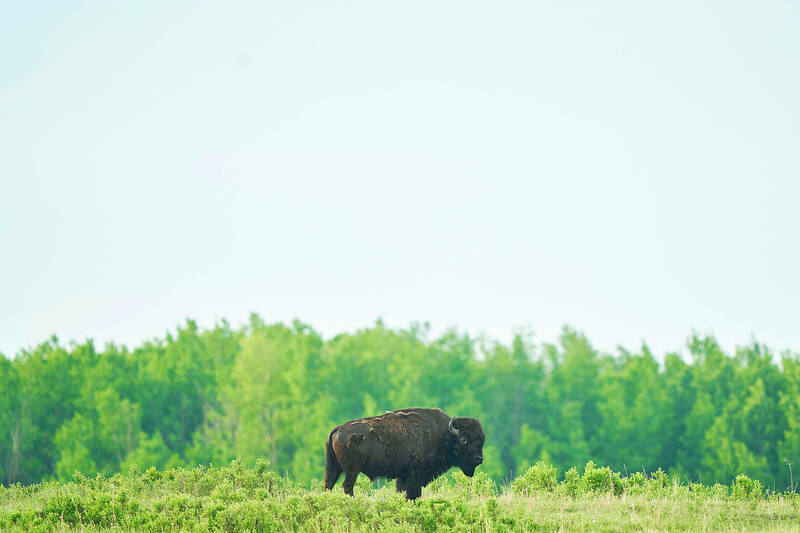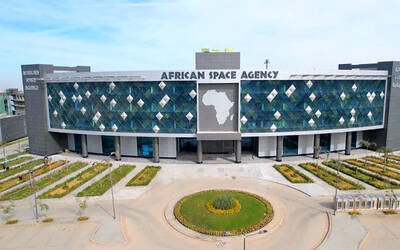Wild bison that once numbered in the tens of millions in North America before being hunted almost to extinction are again thriving in a pocket of western Canada.
Appearing from a distance as specks against the backdrop of the Rocky Mountains, these animals are restoring balance at the top of a fragile ecosystem.
North America’s largest land mammal — growing to 900kg and 1.8m high at the shoulders — experienced a dramatic decline at the end of the 19th century, due to hunting and habitat loss as settlers pushed westward.

Photo: AFP
They were reintroduced to what is now the Canadian Banff National Park in 2017.
“The moment the bison set foot on that landscape, it felt to me that I brought them home,” said former park warden Wes Olson, who accompanied the first 16 bison released there.
Transferred by helicopter from a biosphere reserve near Edmonton, Alberta, the population has expanded and new births are expected to push their numbers to 100 by the end of this year.
A Parks Canada report published this week concluded that the reintroduction was a success, and it suggested that due to their robust growth rate, this bison subpopulation — one of only five that occupy a mere 0.5 percent of their original range in North America — might no longer be considered endangered within one decade.
As soon as they arrived, the ancient ecosystem was reactivated and the bison appeared to feel right at home, Olson said, adding that other forest creatures quickly and “intrinsically” re-established a symbiotic relationship.
Squirrels can be seen collecting hairs shed by the bison, Olson, 69, said, adding that 100 species of insects colonize its nutrient-rich dung.
Birds take turns sitting on bisons’ backs, and pluck bits of fur to make nests, as well as bugs or seeds trapped in it to eat, he said, adding that warmer and more comfortable fur-lined nests lead to better outcomes for the chicks.
A “keystone species” of the Great Plains, a broad expanse of flatlands that stretch across 13 Canadian provinces and US states, from Alberta to Texas, wild bison, by way of their grazing, have shaped the environment.
These “landscape engineers” are on the move as they graze, rather than focus on the same patch of land, with their role somewhat like that of elephants in Africa, International Buffalo Relations Institute executive director Marie-Eve Marchand said.
With herds mobile like that, grasslands can regenerate and store carbon and water more efficiently, a study by the University of Alberta found.
Other studies found that the presence of bison makes grasslands more resilient to drought.
About 30 million to 60 million bison once roamed North America. At the end of the 19th century, there were only a few hundred left.
Their decline had a devastating effect on indigenous people that relied on the animals for food, as well as clothing, shelter and religious worship.
Their return to Banff, an ancestral gathering place of indigenous people, has revived “parts of our language, culture and deep, deep spirituality that the first peoples of this place had with the land,” Marchand said.
Several indigenous communities have been working in recent years to reintroduce bison to their ancestral lands and are eager to do more, including the Tsuut’ina, which started by raising a domestic herd of 400 bison about 100km east of Banff.
The community butchers a few each year for their meat and hides as their ancestors did, while the act of moving the herd from paddock to paddock to mimic their movements in the wild has stirred growth of plants used for indigenous traditional medicines, Tsuut’ina member Clayton Whitney said.
The entire community takes part in the ritual slaughter, with elders passing on their knowledge of how to properly skin the animal, and leaves none of it to waste, he said.

BACKLASH: The National Party quit its decades-long partnership with the Liberal Party after their election loss to center-left Labor, which won a historic third term Australia’s National Party has split from its conservative coalition partner of more than 60 years, the Liberal Party, citing policy differences over renewable energy and after a resounding loss at a national election this month. “Its time to have a break,” Nationals leader David Littleproud told reporters yesterday. The split shows the pressure on Australia’s conservative parties after Prime Minister Anthony Albanese’s center-left Labor party won a historic second term in the May 3 election, powered by a voter backlash against US President Donald Trump’s policies. Under the long-standing partnership in state and federal politics, the Liberal and National coalition had shared power

CONTROVERSY: During the performance of Israel’s entrant Yuval Raphael’s song ‘New Day Will Rise,’ loud whistles were heard and two people tried to get on stage Austria’s JJ yesterday won the Eurovision Song Contest, with his operatic song Wasted Love triumphing at the world’s biggest live music television event. After votes from national juries around Europe and viewers from across the continent and beyond, JJ gave Austria its first victory since bearded drag performer Conchita Wurst’s 2014 triumph. After the nail-biting drama as the votes were revealed running into yesterday morning, Austria finished with 436 points, ahead of Israel — whose participation drew protests — on 357 and Estonia on 356. “Thank you to you, Europe, for making my dreams come true,” 24-year-old countertenor JJ, whose

A documentary whose main subject, 25-year-old photojournalist Fatima Hassouna, was killed in an Israeli airstrike in Gaza weeks before it premiered at Cannes stunned viewers into silence at the festival on Thursday. As the cinema lights came back on, filmmaker Sepideh Farsi held up an image of the young Palestinian woman killed with younger siblings on April 16, and encouraged the audience to stand up and clap to pay tribute. “To kill a child, to kill a photographer is unacceptable,” Farsi said. “There are still children to save. It must be done fast,” the exiled Iranian filmmaker added. With Israel

Africa has established the continent’s first space agency to boost Earth observation and data sharing at a time when a more hostile global context is limiting the availability of climate and weather information. The African Space Agency opened its doors last month under the umbrella of the African Union and is headquartered in Cairo. The new organization, which is still being set up and hiring people in key positions, is to coordinate existing national space programs. It aims to improve the continent’s space infrastructure by launching satellites, setting up weather stations and making sure data can be shared across